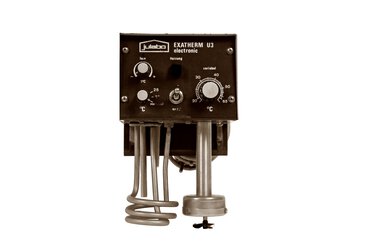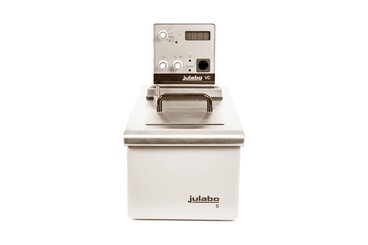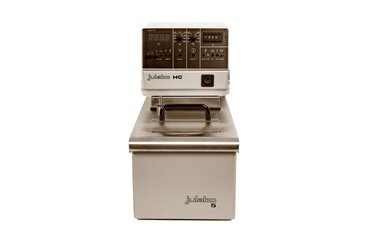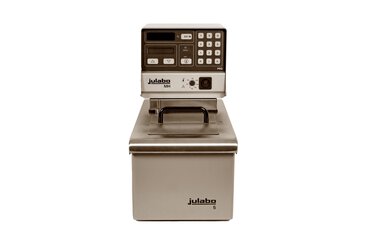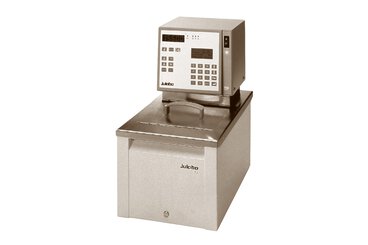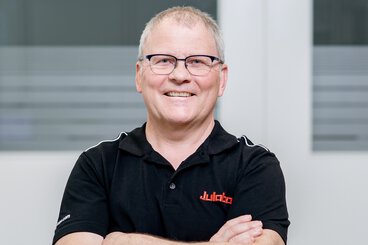JULABO's milestones in temperature control technology
Since its foundation in 1967, JULABO has repeatedly set new standards in the industry as a pioneer in temperature control technology. From the very beginning, the company has dedicated itself to the design of precise, reliable and future-oriented solutions for various industries, establishing itself as one of the most important manufacturers of temperature control systems.
Exatherm U3
One of JULABO's first breakthroughs was the introduction of the Exatherm U3 in 1972, the first electronically controlled circulator. Prior to this, the temperature was controlled using contact thermometers and a two-point controller (on/off), which resulted in insufficient temperature stability.
The Exatherm U3 enabled continuous, analog temperature control with a proportional controller and integral component for the first time, which significantly improved temperature stability.
VC circulators
In the years that followed, JULABO continued to develop its product range. In 1979, the VC circulator revolutionized temperature control with its digital temperature display - a first in the industry. The VC Series had a self-luminous 7-segment LED display with 13 mm high digits that could be easily read even in poor light and from a distance. This allowed laboratory technicians to read the temperature behind protective glass barriers without having to remove the protective wall. In addition, the cumbersome handling of sensitive glass thermometers was no longer necessary, which significantly increased safety and efficiency in the laboratory.
HC circulators
In the 1980s, JULABO impressed the experts with the introduction of the HC circulator, a circulator with a pressure and suction pump. This innovation was particularly important for laboratories with sensitive glass apparatus. Glass apparatus, which is often used for experiments, requires a high flow rate for the supply or removal of thermal energy, but must not be subjected to too much pressure, otherwise they could burst. The pressure and suction pump solved this problem by pushing the fluid into the application and simultaneously drawing it in at the return line. This enabled a higher flow rate at the same pressure and led to more efficient energy transfer - another milestone in temperature control technology.
MH circulators
With the introduction of the MH circulator in the early 90s, JULABO once again set new standards in temperature control. The MH was the world's first circulator with self-optimizing control. Until then, controllers had to be adjusted manually by specialists, which was time-consuming.
The MH circulator automatically adjusted itself to the application during the heating process, significantly reducing the adjustment time and enabling a previously unattainable temperature stability of ±0.01°C.
HighTech TP circulator
Even at the beginning of the 21st century, JULABO remains true to its reputation as a technology leader: the HighTech TP circulator brought significant improvements in self-optimizing control. This now worked not only during heat-up, but also during cool-down. Furthermore, self-optimization could be performed from any start temperature instead of always having to start from room temperature. In addition, the HighTech TP integrated protective functions to protect the temperature control material from possible damage, which offered significant added value for the application.
PRESTO
The PRESTO highly dynamic temperature control systems are the culmination of decades of innovation. Designed for dynamic temperature control, PRESTOs are capable of handling rapid temperature fluctuations while offering high accuracy, making them ideal for demanding applications in research and industry.
PRESTO series
From its first innovations until today's high-performance systems, JULABO has been a leader in the design of groundbreaking solutions that meet the growing needs of its customers worldwide.
"When I joined JULABO in 1991, I immediately noticed the strong culture of innovation. Employees are given creative freedom, always with the aim of improving quality for the customer.
As a result, we quickly succeeded in bundling technical expertise in customer communication: The Technical Service department was born."
Klaus Maier, Head of Technical Service, JULABO

